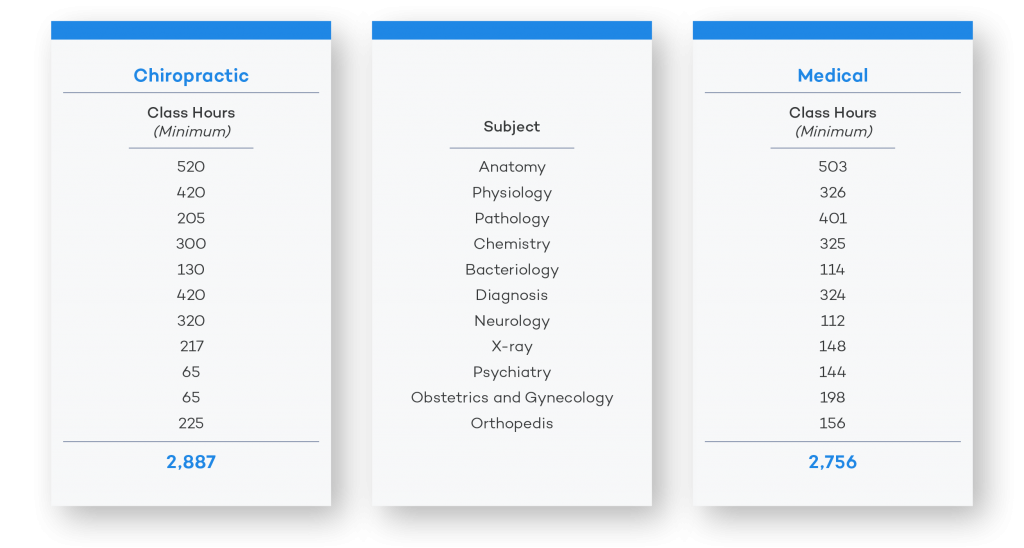Introduction to Chiropractic
Since its formal foundation in 1895, the chiropractic profession has grown into the second largest of the primary health care professions.
In the mid-1970’s, chiropractic experienced rapid growth and acceptance – largely due to positive research findings that validate the benefits of chiropractic care.
In the United States, chiropractic is now included in major insurance and Federal programs such as Workers’ Compensation, Medicare and Medicaid.
Legislation has also been enacted calling for the inclusion of chiropractic services in both the military and the Veterans Administration. Still, many people are unfamiliar with chiropractic and how it may benefit their health.
Educational Requirements:
DC degree (Doctor of Chiropractic) vs.
MD degree (Doctor of Medicine)
Today’s Doctors of Chiropractic Typically Have Eight or More Years of College
Have you ever wondered just how much education your chiropractor has? The facts may very well surprise you.
Today, at least eight years of highly specialized college training are required to graduate and earn licensure, and chiropractic has gained recognition as a comprehensive, scientifically sound force among the healing arts. Only chiropractic concerns itself with the interrelationship of structure and body functions, and only chiropractic effectively utilizes natural, drugless methods of treatment – primarily spinal adjustments.
Look at these typical basic educational requirements for medical school graduates as compared to those for Doctors of Chiropractic.
The chiropractor must meet stringent educational requirements, including approximately 600 hours of externship, which qualify him for licensure in all states and Canadian provinces. In many states, he must pass a basic science examination – the same examination that is given to medical students. He must also pass a rigid chiropractic board examination, and his state probably requires continuing educational seminars for annual license renewal.
If you have friends who are uninformed or misinformed about chiropractic education, why not share this knowledge with them? They, too, may benefit from today’s scientific chiropractic care.
You may be surprised to know that Chiropractors are trained very similarly to medical doctors! The major differences between the two curriculums are:
- Chiropractic schools focus more on treating disease (primarily of nerve, muscle and bone) with chiropractic manipulative therapy, nutrition, prevention and lifestyle education; treating the body as a whole.
- Medical schools focus more on treating disease with pharmacotherapy (drugs) and surgical procedures.
YOU ARE IN GOOD HANDS WITH CHIROPRACTIC!
The following chart was compiled from a review of the catalogues of 22 medical schools and 11 chiropractic colleges and updates from the National Health Federation Bulletin.

When medical doctors graduate from their 4 years of schooling they do not yet have their specialty. In order to become a specialist in musculoskeletal care a medical doctor does a residency in Orthopedics and becomes an Orthopedist specialist. A Chiropractor gets approximately 2000 hours of musculoskeletal education “mixed in” with their 5 year Chiropractic course. Thus a Chiropractor is a musculoskeletal specialist.
During the 4-5 year program, doctors must have completed a number of national board exams required for licensure. Several hundred hours of internship are undergone under the professional supervision of a Doctor of Chiropractic. Many doctors also undergo an externship program to further adapt themselves to actual clinical practice.
After graduation, national board exams I-IV must have been passed, and depending on the individual state, a state board exam may have been given. Once these tasks have been met, a license to practice chiropractic will be granted.
Each state requires continuing education of your chiropractor and the majority of doctors routinely exceed the mandatory CE requirements to ensure knowledge of latest techniques.
To put all this in perspective, the average medical doctor will attend approximately 4,250 hours of education depending on specialty and the average doctor of chiropractic has attended 4,485 hours of education.
Other Chiropractic Facts
- There are 60,000 Doctors of Chiropractic (DCs) in active practice in the US.
- More than 10,000 students are currently enrolled in chiropractic educational programs accredited by a federally recognized body (CCE).
- DCs are licensed in all 50 states, the District of Columbia and Puerto Rico and have been so for many decades.
- DCs are authorized to be commissioned as health care officers in the U.S. Armed Forces.
- In 1993, more than 30 million consumers made chiropractic a regular part of their healthcare program.
Don’t forget to share this via Twitter, Google+, Pinterest, LinkedIn, Digg, Tumblr, Reddit, StumbleUpon and Delicious.
